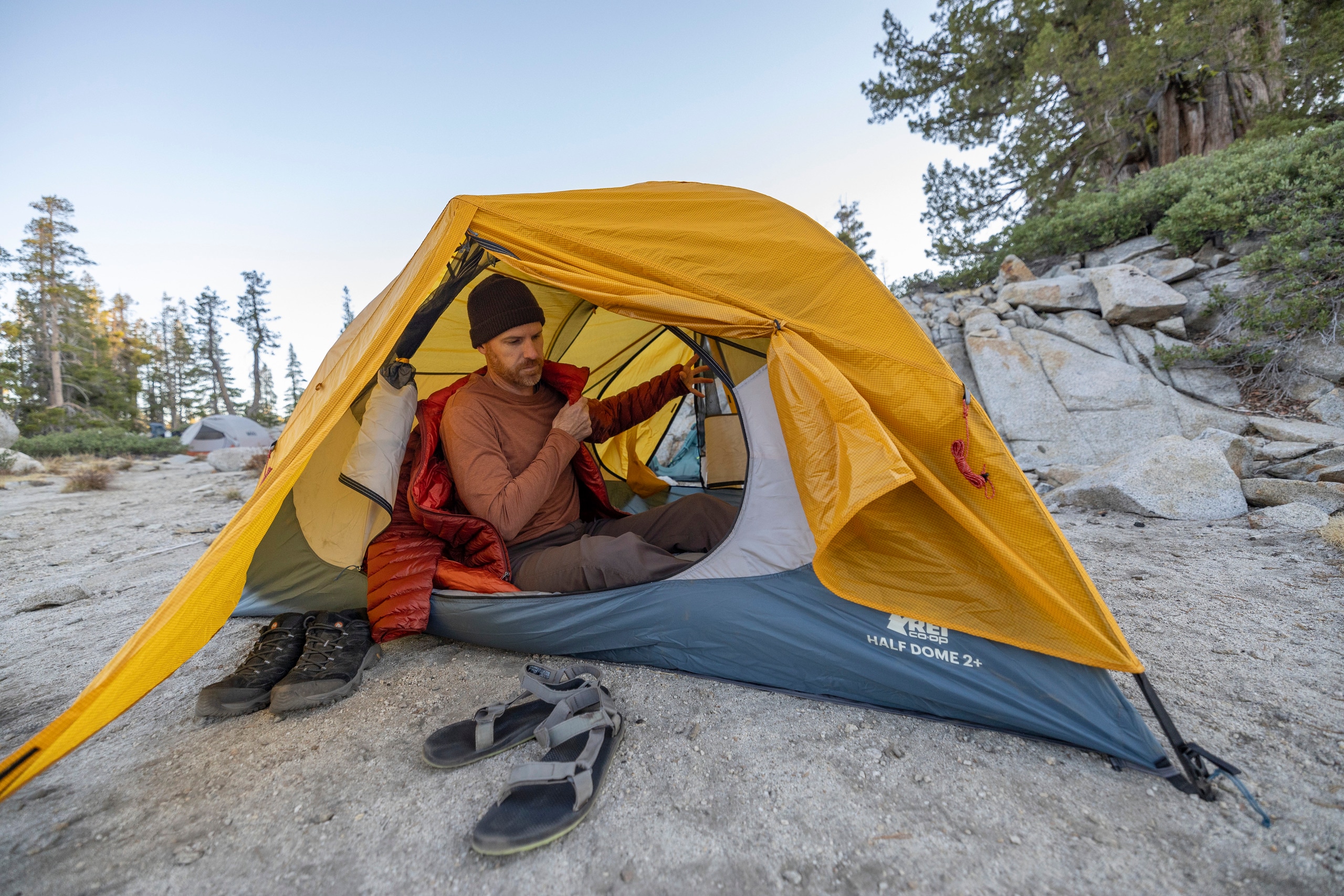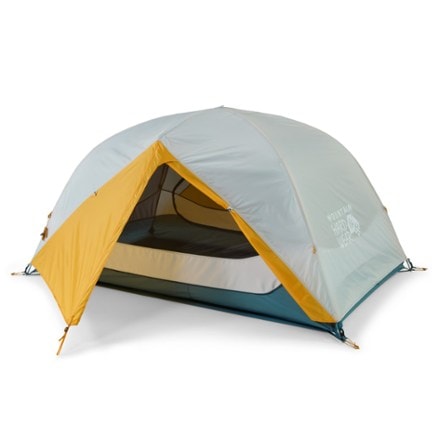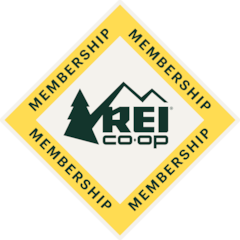How to Choose a Backpacking Tent

Adventure-ready wherever your plans take you, the Mountain Hardwear Mineral King 2 tent comes with a footprint and is spacious enough for car camping, yet light enough for multiday backpacking trips.




$32
10% Reward
on this and every eligible full-price item*
+
$30
Bonus Card
valid for 30 days after joining*
=
$62
Value
Keep shopping
Imported.
View all Mountain Hardwear Backpacking Tents| Best Use | Backpacking |
|---|---|
| Seasons | 3-season |
| Sleeping Capacity | 2-person |
| Minimum Trail Weight | 5 lbs. 7.9 oz. |
| Fly / Footprint Pitch Weight | Unavailable |
| Packaged Weight | 6 lbs. 8 oz. |
| Packed Size | 6 x 24 inches |
| Floor Dimensions | 88 x 54 inches |
| Floor Area | 33 square feet |
| Vestibule Area | 18.75 square feet |
| Peak Height | 43 inches |
| Number of Doors | 2 doors |
| Number of Poles | 2 |
| Pole Material | DAC Pressfit |
| Pole Diameter | 9 millimeters |
| Canopy Fabric | Fabric Canopy: 40-denier polyester mesh; 75-denier ripstop 100% polyester |
| Floor Fabric | 68-denier 210T ripstop polyester; 1,500 mm polyurethane 100% polyester |
| Rainfly Fabric | 68-denier ripstop polyester; 2,000 mm polyurethane/polyester |
| Footprint Included | Yes |
| Design Type | Freestanding |
Adding a review will require a valid email for verification
Took this tent out for 2 nights and it did not disappoint. I had two nights of rain and the tent performed beyond expectations. The last night it started raining at midnight and never stopped till 7 am I woke up and was surprised the site had filled with water but the tent did its job and the bathtub flooring kept all the water out (see pic) I was was solo on this trip but could see 2 people having enough room in this tent. Tent had good venting but I had to keep the rain fly on the whole trip. This tent is constructed very well and sets up in minutes. I have always wanted a Mountain Hardware tent and I am glad I finally got one. This is a great tent for car camping I could see it as a backpack tent for two if you split the tent up between the two people. If I could change one thing it would be the color of the rain fly not sure how I feel about the white see it getting very dirty But Again just a Great Tent
I buy a lot of tents (at least one a year) and this is my fav car camping tent. What I like * Small package (love how little space it takes) * Great rain coverage and nice vestibule * Dual doors * Comes with ground cloth * Lots of pockets * Mounting points on top for lights * Line on top for drying clothes What could improve * Two guidelines are provided but there are 6 places you might want to tie the tent down * You need to slide the pole into a tent sleeve when assembling, I usually forget and then have to backtrack. I wish it was all hooks. I've had a few Mineral King tents and this is the best iteration by far.
I love this tent, especially for car camping! The poles make it so you have more room around your shoulders and head; it feels super spacious. It's also really easy to set up. I also appreciate that it's affordable, which is awesome to see a technical company like Mountain Hardwear offer. I'm pretty new to camping and purchasing equipment especially can be intimidating, but this tent was a perfect choice. The other nice touch is that it doesn't have flame retardant chemicals. So when I'm out in the nature, I can breathe in the fresh air instead of toxic chemicals and not worry about having to wash my hands after set-up and break-down.
Great tent for what it was designed for. Lightweight but never ever for backpacking unless the Boy Scouts where they haul 60 pounds for 4 or 5 miles. This tent is the bomb for backyard or car camping. It came with its own footprint to protect the already quite durable floor. The poles are pre bent and sturdy. It freestands, which is a convenient plus for setting up, taking down, or moving it to a more level spot! The fly is simple and durable. You will want to keep the fly partially off unless you are getting rained on. The tent ventilates well, but the fly really seals it up, so watch out for condensation. This tent is the one to have!
I've had other tents that have been a nightmare to deal with. I took this on an overnight backpacking trip into a thick-brush area in a National Forest area. Comes with a solid footprint, and the easiest frame setup I've dealt with thus far. Tent was up and ready in less than a minute. Didn't use the tarp, and had a beautiful view of the stars and comet during New Moon the other night. Very spacious, and will accomodate my wife and I with more than enough space, when she comes with me on the next trip. My friend who has been backpacking for many years was jealous of how beautifully made this tent is. Don't hesitate to buy.
Took this tent into the Boundary Waters for a week. High winds, thunder storms and even hail couldn’t shake this tent! One of the best Buy’s I’ve made for camping!!!
What a great tent! It's an exceptional value as well considering the quality, features, and the included footprint. Not the lightest, but it is very solidly built (the zippers are a bit heavy to open but I'm assuming it's because they are heavy duty). I especially love the two large pockets at both ends of the tent (reinforced every third) and the easy access doors that open fully. Thoughtful design with color coded poles as well. I'm not sure what the opaque panels between the no-seeum and the bathtub floor is called, but I like that it sits lower than some tents so allows for a more panoramic view when camping fly-less. While not exactly comparing apples to apples, I switched from a HH UL2 to this.
Solid tent, but I think it cheapest the product when they only supply enough pegs to anchor its 4 corners to the ground, and peg out the vestibule. It needs 12 pegs, not 6, and 4 wind lines, not 2, to properly ventilate and tie it down for wind.
The large doors with their own stuff pockets are wonderful. Its super easy to get in/out of the tent. It feels like a 3 man with the head space as well. If you're not looking for a 4 lb tent, but a 6 lb will do. I highly recommend this king!!
This tent is built strong to last long, heavier fabric, stronger polls than a lightweight backpacking tent. Carrying extra weight on some trips is well worth it, what do you have with a failed tent. This tent withstood fairly high winds with heavy rain, no issue. Yes I do have a 2.2lb tent it is not for all occasions.